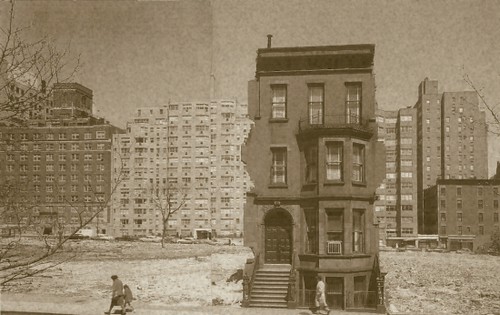Missing the real point: city (re)development isn't about "gentrification" as much as it is about urbanism and urban design
Once upon a time, a newcomer to the big city was most likely a country bumpkin obliged to make his way among the sophisticates. But the in-migration today is coming from the suburbs, whose denizens are relatively well-off and capable of wielding cultural power in their new neighborhoods.
Whatever is making them leave the suburbs, they appear to be bringing their suburban tastes with them, and remaking the city in their image. Demographers find that these urban newcomers are split between suburban-raised upwardly mobile professionals and empty-nesters.
The truth is that we've been screwed in both directions. (Also see the blog entry from 2006, "The fifth phase of center-city revitalization.")
First, the 1960s-1970s (and still pretty much in force today) social justice/community development/urban renewal rehabilitation strategy for the city focused on remaking the city over for the automobile, bringing in strip shopping centers, malls, tearing down lots of buildings for parking lots, constructing grim looking but new housing, etc.
For the most part, these strategies didn't work, although here and there are some urban renewal communities and business districts that do reasonably well (Lafayette Park in Detroit, the Golden Triangle in Pittsburgh).
Second, from the late 1950s onward, simultaneously there were waves of so-called urban pioneers who came to or stayed in the city because they appreciated the urban qualities of city life, and they worked to stabilize and reclaim otherwise dying neighborhoods, and they worked to fight off urban renewal and/or freeway building programs that threatened neighborhoods.
From the article:
Victorian homes had fallen into disfavor and many middle-class New Yorkers were moving to the suburbs by 1963, when Mrs. Ortner and her husband bought a four-story 1886 brownstone on Berkeley Place in Park Slope.
Mrs. Ortner, an interior designer before she became a preservationist, was so enchanted by that house, with its original mahogany woodwork and papier-mâché and linseed-oil wallpaper, that she began a campaign to save thousands of other brownstones from neglect or the wrecking ball.
Many of the graceful 19th-century single-family homes in Park Slope were owned by absentee landlords and had been cut up into rooming houses. In other parts of New York, old homes were being lost to federally sponsored urban renewal projects.
The Ortners decided to make brownstones — and Brooklyn — appealing to many people who had never considered anything but apartment life in Manhattan. To attract other preservationists, the Ortners and a small group of likeminded Brooklynites began conducting some historic-house tours to present dilapidated houses as opportunities. Mrs. Ortner publicized the tours by dressing in antique clothing and posing for newspaper photographers.
Most have not. And in any case, it's a long process, and if you don't reach critical mass of people able to withstand the inertia of expectations and the increasing velocity that can be associated with disinvestment, you lose. That's what has happened in cities like Cleveland or St. Louis.

Third, even the "urban pioneers" came of an age when the suburban style of planning around automobility and separated uses became the dominant land use and transportation planning paradigm in the U.S.
By contrast, today, to satisfy the tastes of suburban newcomers, developers seek to tame stark differences and impose some standardization on the city. The primary example is the remake of Times Square in Manhattan. Once the epitome of the juxtaposition of grime and glitz, Times Square is now, in the words of geographers Neil Smith and Deborah Cowen, "dense with suburban, clean, white middle-class faces and bodies with the odd 'exotic' mixed in." Newsday columnist Jimmy Breslin once called it a shift from hookers to Mickey Mouse. But it's really about the tendency to turn cities into what Smith and Cowen have called "suburbs with pizzazz."
In L.A., the latest example is L.A. Live, with its manufactured promenades and brand names. In Washington, it's a massive new apartment complex atop a big-box Giant grocery store on once-scruffy, quickly gentrifying H Street. The calculation is that this is what the newcomers want.
... categories of production and labor in the urban context have been severely impacted by post-industrial and globalizing trends; cultural activities are increasingly crucial to urban economic vitality. Models used to explain the growth of cities during industrial, “Fordist” capitalism are outmoded. Loss of heavy industry impacts the dynamics of urban growth, increasing the relative importance of the city both as a space of consumption and as a site for “production” which is distinctly symbolic/expressive. Even in a former industrial power like Chicago, the number one industry has become entertainment, which city officials define as including tourism, conventions, restaurants, hotels, and related economic activities. Workers in the elite sectors of the postindustrial city make “quality of life” demands, and in their consumption practices can experience their own urban location as if tourists, emphasizing aesthetic concerns. These practices impact considerations about the proper nature of amenities to provide in contemporary cities. The city becomes an Entertainment Machine leveraging culture to enhance its economic well being. The entertainment components of cities are actively and strategically produced through political and economic activity. Entertainment becomes the work of many urban actors. These are the main themes we elaborate below.
Labels: arts-culture, commercial district revitalization planning, music-entertainment, retail enterpreneurship development, urban design/placemaking, urban revitalization, urban vs. suburban





0 Comments:
Post a Comment
<< Home